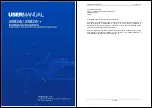
212 C
OMMAND
C
ENTER
S
ECURE
G
ATEWAY
A
DMINISTRATOR
G
UIDE
Using Traceroute (Network Interfaces)
Traceroute is often used for network troubleshooting. By showing a list of routers traversed, it
allows you to identify the path taken from your computer to reach a particular destination on the
network. It will list all the routers it passes through until it reaches its destination, or fails to and
is discarded. In addition to this, it will tell you how long each 'hop' from router to router takes.
This can help identify routing problems or firewalls that may be blocking access to a site.
1.
To perform a traceroute on an IP address or hostname, click
Operation
,
Network Interfaces
,
then
Traceroute
.
Figure 267 Performing Traceroute on a Target
2.
Enter the IP address or hostname of the target you wish to check in the
Traceroute Target
field.
3.
Optionally, select:
OPTION
DESCRIPTION
Verbose
Verbose output, which lists received ICMP packets other
than TIME_EXCEEDED and UNREACHABLEs.
No DNS Resolution
Does not resolve addresses to host names.
Use ICMP (vs. normal UDP)
Use ICMP ECHO instead of UDP datagrams.
4.
Optionally, type values for how many hops the traceroute command will use in outgoing
probe packets (default is 30), the UDP destination port to use in probes (default is 33434),
and the size for the traceroute packets. If left blank, defaults will be used.
5.
Click
Traceroute
in the bottom right-hand corner of the window.
6.
Press
CTRL+C
or
CTRL+Q
to terminate the traceroute session. A
Return?
prompt appears;
press
ENTER
to return to the Traceroute menu. The
Return?
prompt also appears when
Traceroute terminates due to “destination reached” or “hop count exceeded” events occur.
Editing Static Routes (Network Interfaces)
In Static Routes, you can view the current IP routing table and modify, add, or delete routes.
Careful use and placement of static routes may actually improve the performance of your network,
allowing you to conserve bandwidth for important business applications and may be useful for
Summary of Contents for Command Center CC-SG
Page 2: ...This page intentionally left blank...
Page 16: ......
Page 34: ...18 COMMANDCENTER SECURE GATEWAY ADMINISTRATOR GUIDE...
Page 64: ...48 COMMANDCENTER SECURE GATEWAY ADMINISTRATOR GUIDE...
Page 122: ...106 COMMANDCENTER SECURE GATEWAY ADMINISTRATOR GUIDE...
Page 168: ...152 COMMANDCENTER SECURE GATEWAY ADMINISTRATOR GUIDE...
Page 252: ......
Page 254: ...238 COMMANDCENTER SECURE GATEWAY ADMINISTRATOR GUIDE...
Page 258: ...242 COMMANDCENTER SECURE GATEWAY ADMINISTRATOR GUIDE...
Page 260: ...244 COMMANDCENTER SECURE GATEWAY ADMINISTRATOR GUIDE...
Page 268: ...252 COMMANDCENTER SECURE GATEWAY ADMINISTRATOR GUIDE 255 80 5140 00...
Page 269: ...APPENDIX G FAQS 253...
















































